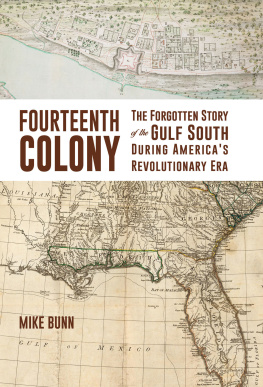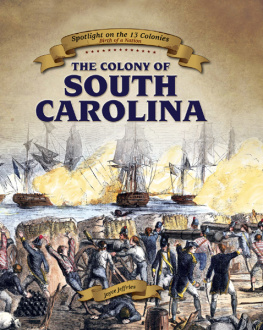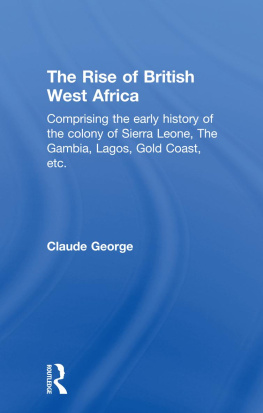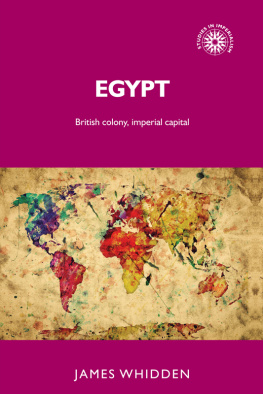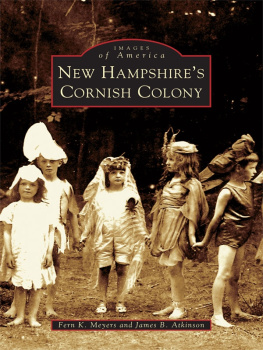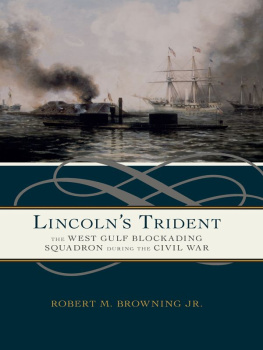Contents
Guide
Fourteenth Colony

ALSO BY MIKE BUNN
The Assault on Fort Blakeley:
The Thunder and Lightning of Battle
Early Alabama:
An Illustrated Guide to the Formative Years, 17981826
Alabama from Territory to Statehood:
An Alabama Heritage Bicentennial Collection [co-author]
Well Worth Stopping to See:
Antebellum Columbus, Georgia, Through the Eyes of Travelers
Civil War Eufaula
Battle for the Southern Frontier:
The Creek War and the War of 1812
Images of America:
The Lower Chattahoochee River

NewSouth Books
105 S. Court Street
Montgomery, AL 36104
Copyright 2020 by Mike Bunn
All rights reserved under International and Pan-American Copyright Conventions.
Published in the United States by NewSouth Books, Montgomery, Alabama.
Library of Congress Cataloging-in-Publication Data
Names: Bunn, Mike, author.
Title: Fourteenth colony : the forgotten story of the Gulf South during Americas Revolutionary era / Mike Bunn.
Other titles: Forgotten story of the Gulf South during Americas Revolutionary era
Description : NewSouth Books, [2020] | Includes bibliographical references and index.
Identifiers: LCCN 2020018838 (print) | LCCN 2020018839 (ebook) | ISBN 9781588384133 (Trade Cloth) | ISBN 9781588384140 (epub) Subjects: LCSH: West FloridaHistory18th century. | West
FloridaHistory, Military18th century. | FloridaHistoryEnglish colony, 1763-1784. | FloridaHistoryRevolution, 1775-1783. | American loyalistsFlorida.
Classification: LCC F301 .B86 2020 (print) | LCC F301 (ebook) | DDC 975.9/02--dc23
LC record available at https://lccn.loc.gov/2020018838
LC ebook record available at https://lccn.loc.gov/2020018839
Design by Randall Williams
Printed in the United States of America by Sheridan

The Black Belt, defined by its dark, rich soil, stretches across central Alabama. It was the heart of the cotton belt. It was and is a place of great beauty, of extreme wealth and grinding poverty, of pain and joy. Here we take our stand, listening to the past, looking to the future.
To Zoey, my light and inspiration
Contents
T he Revolutionary Era is one of the most storied and studied time periods in Americas compelling national saga. Conjuring visions of righteous colonial protests in Boston Harbor, sober state-making in the chambers of Independence Hall in Philadelphia, and martial determination on the frigid meadows at Valley Forge, the 1760s and 1770s are venerated by Americans for having witnessed the formation of the United States from the cooperative efforts of thirteen former British colonies. It is an era studded with iconic moments and rich with legendary figures that are a part of our shared national canon. It is sadly ironic that this grand pageant is a heritage from which Gulf Coast residents have long felt detached owing in large part to geography, for an important but little known chapter in Americas colonial and Revolutionary drama played out along their sunny shores.
British West Florida, stretching from the mighty Mississippi to the shallow bends of the Apalachicola and incorporating large portions of what are now the states of Louisiana, Mississippi, Alabama, and Florida, is the forgotten fourteenth colony in Americas founding era. The colony and its sister province, East Florida, were erected by the British at the conclusion of the Seven Years War in 1763 on the ruins of the vast but rather vaguely defined territory formerly claimed by French and Spanish colonials. Headquartered in Pensacola originally, with scarcely a European settlement west of Mobile Bay, the province grew exceedingly slowly and only began to come of age as the Revolutionary War flared up along the Atlantic seaboard. Eventually the colony featured clusters of European settlements at such places as Pensacola, Campbelltown, Mobile, Baton Rouge, Manchac, and Natchez, and it assumed a position as a dynamic and promising part of Britains North American holdings. But despite the grand visions of its leaders and the best efforts of its residents, the colony struggled economically and its representative government never quite became the force in provincial life that similar institutions in the east coast colonies did. In fact, West Florida is so obscure to us today at least in part owing to its relatively small population and its pressing daily concerns; the latter occupied residents and precluded their becoming a vital part of intercolonial discussions during a period of political unrest. As it remained officially loyal to the crown throughout the Revolution, West Florida is usually regarded as an afterthought where little of consequence occurred.
YET THE REVOLUTION DID find the colony, and the story of the ways it did so colorfully and substantively shapes the history of the region. First came politely declined invitations by the Continental Congress to join its sister provinces to the east in working towards the establishment of a new, independent American nation. Next came a wave of immigration after being declared a safe asylum for besieged loyalists elsewhere. In 1778 came a daring raid by a ragtag American force along the Mississippi which exposed the provinces inadequate defenses and caused a great deal of unrest even if never seriously threatening its takeover by a Continental army. Finally came an audacious, prolonged, offensive spearheaded by the ambitious and capable governor of neighboring Spanish Louisiana, Bernardo de Galvez, which would ultimately bring about the end of West Floridas days as a part of the British Empire. Spain never formally allied itself with the nascent United States in its war for independence, but it recognized an opportunity to take advantage of a distracted colonial rival. Spains stunning campaign to wrest control of West Florida from the British featured intense and spirited fighting from the fall of 1779 to the spring of 1781. This war within a war helped divert vital resources from other Revolutionary War campaigns by the British and culminated in the martial conquest of the colony by the Spaniards.
But despite all this, somewhat few people know the colony existed at all. A forgotten Gulf Coast entity which graced regional maps for less than two decades, the province goes virtually unmentioned in most histories of the American Revolutionary Era and is all but unknown to the great majority of those living within its former borders today. The situation is understandable to some degree, as precious few historical sites commemorate the people, places, and events of the regions years as part of the British Empire, and almost no extant structures date to its mid-eighteenth century heyday. Its name alone can confuse some, to boot, as West Florida naturally connotes to the modern ear a certain geographical specificity that takes some explaining to communicate the true physical footprint of the colony. Save for the findings of some archaeological investigations and a few scattered historic markers (and one magnificent memorial statue in Pensacola), the British period in Gulf Coast history can only be imagined through the pages of the rather limited historiography on the subject. While that historical literature is solid and features the work of some eminent colonial historians, candidly it is not exactly brimming with best-sellers likely to be familiar to the casual historian. But the fact that the seminal events in Americas founding dramathe political unrest and legendary war between the immortal thirteen rebellious colonies and Great Britain which witnessed the birth of the United States as an independent nationoccurred far away from the Gulf has probably been most responsible for rendering West Floridas story so overlooked, understudied, and poorly understood. Scores of textbooks and narrative histories chronicling the era do not so much as mention British West Florida, much less discuss its place in the Empire. It is not uncommon to find within these books maps depicting Britains North American colonies during the Revolution as existing only along the eastern seaboard, with the amorphous southwestern frontier behind them labeled as simply Indian land or Spanish territory. In short, Americans, both scholars and lay historians, often so associate our nations founding era with the thirteen rebellious colonies that we have collectively forgotten that there even was an America farther west than the Atlantic coast in 1776.
Next page
